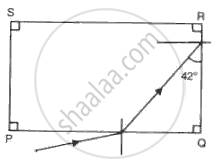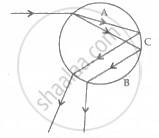Advertisements
Advertisements
प्रश्न
Can light be ‘piped’ like sound in a doctor’s stethoscope?
उत्तर
Yes, light can be piped from one end to the other with little loss by allowing it to enter one end of a rod of transparent material. The light will undergo total internal reflection at the wall of the rod and will proceed along its axis. This actually being achieved by using a bundle of glass fibers.
APPEARS IN
संबंधित प्रश्न
Which colour of light has a higher critical angle? Red light or green light.
One day Chetan’s mother developed a severe stomach ache all of a sudden. She was rushed to the doctor who suggested for an immediate endoscopy test and gave an estimate of expenditure for the same. Chetan immediately contacted his class teacher and shared the information with her. The class teacher arranged for the money and rushed to the hospital. On realizing that Chetan belonged to a below average income group family, even the doctor offered concession for the test fee. The test was conducted successfully.
Answer the following questions based on the above information:
(a) Which principle in optics is made use of in endoscopy?
(b) Briefly explain the values reflected in the action taken by the teacher.
(c) In what way do you appreciate the response of the doctor on the given situation?
Total internal reflection can take place only if ______.
If a light ray does not undergo, refraction at the boundary between two media, the angle of incidence is:
(a) A ray of monochromatic light enters glass PQRS as shown in the fig. Complete the path of ray till it emerges from the glass. (Critical angle of glass is 420).

(b) Draw diagram of a prism periscope.
(c) What are the advantages of total internal reflecting prism over plane mirror?
Express the refractive index μ of a medium in terms of the angle of incidence i in air and the angle of refraction r in a denser medium.
Define the critical angle.
What are the conditions to achieve total internal reflection?
Observe the given figure of the raindrop and answer the following questions:

- Label A and B of the given diagram. Why colour will deviate most.
- Name the phenomenon shown in label C.
